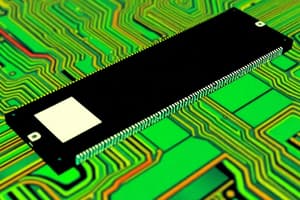Podcast
Questions and Answers
Which of the following factors does NOT directly affect CPU performance?
Which of the following factors does NOT directly affect CPU performance?
- Software type (correct)
- Clock speed
- Number of cores
- Cache size
What is a primary advantage of a dual-core processor compared to a single-core processor?
What is a primary advantage of a dual-core processor compared to a single-core processor?
- It operates at a higher clock speed.
- It has more cache memory.
- It can process instructions independently. (correct)
- It is always faster in all applications.
Why might a quad-core processor not always run twice as fast as a dual-core processor?
Why might a quad-core processor not always run twice as fast as a dual-core processor?
- Quad-core processors have less cache memory.
- There is always a bottleneck with RAM.
- Some applications are not optimized for multiple cores. (correct)
- Power consumption is generally higher in quad-core models.
What is the role of cache in CPU performance?
What is the role of cache in CPU performance?
Which statement about cache memory is true?
Which statement about cache memory is true?
What does a dual core processor primarily improve in a computer's performance?
What does a dual core processor primarily improve in a computer's performance?
In the context of CPU performance, what is the significance of clock speed?
In the context of CPU performance, what is the significance of clock speed?
What does the cache in a computer do?
What does the cache in a computer do?
During which stage of the fetch-execute cycle does data from RAM get fetched?
During which stage of the fetch-execute cycle does data from RAM get fetched?
How many cycles can a 4.2 GHz processor perform in one second?
How many cycles can a 4.2 GHz processor perform in one second?
Which component of the CPU is responsible for performing arithmetic calculations?
Which component of the CPU is responsible for performing arithmetic calculations?
What is the primary function of the Control Unit in the CPU?
What is the primary function of the Control Unit in the CPU?
Which of the following factors influences CPU performance the least?
Which of the following factors influences CPU performance the least?
In which year did the maximum clock speed reach 4 GHz?
In which year did the maximum clock speed reach 4 GHz?
What does the Program Counter (PC) store?
What does the Program Counter (PC) store?
Which characteristic of CPUs allows them to process multiple tasks simultaneously?
Which characteristic of CPUs allows them to process multiple tasks simultaneously?
What historical trend has been observed in CPU clock speeds over the last 80 years?
What historical trend has been observed in CPU clock speeds over the last 80 years?
Which component in a CPU is responsible for storing the instructions that are currently being processed?
Which component in a CPU is responsible for storing the instructions that are currently being processed?
What is the primary function of the CPU?
What is the primary function of the CPU?
Early fixed-program computers required what to change their tasks?
Early fixed-program computers required what to change their tasks?
Which of the following describes hardware in a computer system?
Which of the following describes hardware in a computer system?
What does the term 'fetch-execute cycle' refer to?
What does the term 'fetch-execute cycle' refer to?
Who first published the concept of Von Neumann architecture?
Who first published the concept of Von Neumann architecture?
Which of the following is NOT a characteristic of early fixed-program computers?
Which of the following is NOT a characteristic of early fixed-program computers?
In the context of computer systems, what is considered software?
In the context of computer systems, what is considered software?
What is a common task of input devices in a computer system?
What is a common task of input devices in a computer system?
What is the primary function of the Control Unit (CU)?
What is the primary function of the Control Unit (CU)?
Which of the following is NOT one of the five registers in a CPU?
Which of the following is NOT one of the five registers in a CPU?
What roles do the Arithmetic Logic Unit (ALU) perform?
What roles do the Arithmetic Logic Unit (ALU) perform?
Which register holds the address of the memory location to be accessed?
Which register holds the address of the memory location to be accessed?
In the context of CPU architecture, what does the term 'Cache' refer to?
In the context of CPU architecture, what does the term 'Cache' refer to?
Which component of the CPU is comparable to a conductor in an orchestra?
Which component of the CPU is comparable to a conductor in an orchestra?
Which of the following statements accurately describes the Memory Data Register (MDR)?
Which of the following statements accurately describes the Memory Data Register (MDR)?
Which operation is specifically performed by the Arithmetic Logic Unit (ALU)?
Which operation is specifically performed by the Arithmetic Logic Unit (ALU)?
What is a key characteristic of embedded systems?
What is a key characteristic of embedded systems?
Which of the following is NOT an example of an embedded system in cars?
Which of the following is NOT an example of an embedded system in cars?
What is the primary function of an engine control unit in a car?
What is the primary function of an engine control unit in a car?
In terms of power usage, how are embedded systems typically designed?
In terms of power usage, how are embedded systems typically designed?
How many main components are typically found on the circuit board of an embedded system?
How many main components are typically found on the circuit board of an embedded system?
Which system is specifically designed to automate the task of parking a vehicle?
Which system is specifically designed to automate the task of parking a vehicle?
What differentiates embedded systems from general-purpose systems?
What differentiates embedded systems from general-purpose systems?
Which of the following best describes the integration of embedded systems?
Which of the following best describes the integration of embedded systems?
Flashcards
What is the purpose of the CPU?
What is the purpose of the CPU?
The Central Processing Unit (CPU) is the brain of a computer. It fetches instructions from the memory and executes them.
What is the fetch-execute cycle?
What is the fetch-execute cycle?
The fetch-execute cycle is a continuous process where the CPU fetches instructions, decodes them, and executes them.
What is hardware?
What is hardware?
Hardware refers to the physical components of a computer system that you can touch, such as the keyboard, monitor, and motherboard.
What is software?
What is software?
Signup and view all the flashcards
What is an input device?
What is an input device?
Signup and view all the flashcards
What is an output device?
What is an output device?
Signup and view all the flashcards
What were fixed-program computers?
What were fixed-program computers?
Signup and view all the flashcards
What is the Von Neumann architecture?
What is the Von Neumann architecture?
Signup and view all the flashcards
Dual-Core Processor
Dual-Core Processor
Signup and view all the flashcards
Single-Core Processor
Single-Core Processor
Signup and view all the flashcards
Clock Speed
Clock Speed
Signup and view all the flashcards
Cache
Cache
Signup and view all the flashcards
Number of Cores
Number of Cores
Signup and view all the flashcards
Control Unit (CU)
Control Unit (CU)
Signup and view all the flashcards
Arithmetic Logic Unit (ALU)
Arithmetic Logic Unit (ALU)
Signup and view all the flashcards
Registers
Registers
Signup and view all the flashcards
Von Neumann Architecture
Von Neumann Architecture
Signup and view all the flashcards
Program Counter (PC)
Program Counter (PC)
Signup and view all the flashcards
Memory Address Register (MAR)
Memory Address Register (MAR)
Signup and view all the flashcards
Memory Data Register (MDR)
Memory Data Register (MDR)
Signup and view all the flashcards
MAR (Memory Address Register)
MAR (Memory Address Register)
Signup and view all the flashcards
MDR (Memory Data Register)
MDR (Memory Data Register)
Signup and view all the flashcards
Multi-core Processor
Multi-core Processor
Signup and view all the flashcards
Cache Size
Cache Size
Signup and view all the flashcards
Embedded Systems
Embedded Systems
Signup and view all the flashcards
Characteristics of Embedded Systems
Characteristics of Embedded Systems
Signup and view all the flashcards
Low Power Consumption
Low Power Consumption
Signup and view all the flashcards
Limited Functions
Limited Functions
Signup and view all the flashcards
Part of a Larger Machine
Part of a Larger Machine
Signup and view all the flashcards
Single Circuit Board
Single Circuit Board
Signup and view all the flashcards
Embedded Systems vs. General-Purpose Systems
Embedded Systems vs. General-Purpose Systems
Signup and view all the flashcards
Examples of Embedded Systems
Examples of Embedded Systems
Signup and view all the flashcards
Study Notes
Chingford Foundation School
- Vision: Building ambition for all.
- Mission: A community where students strive to be the best version of themselves.
- Core Values: Achievement, Resilience, Unity
CPU Architecture
- Purpose: The Central Processing Unit (CPU) fetches and executes instructions stored in memory.
- Fetch-execute cycle: The CPU executes program instructions through the fetch-execute cycle, also known as the fetch-decode-execute cycle. This cycle involves fetching instructions from RAM, decoding the instructions, executing the instructions, and repeating the process.
- Components: A CPU includes the Control Unit (CU), Arithmetic Logic Unit (ALU), registers (ACC, MAR, MDR, PC, CIR), and cache.
- Registers: Small memory locations within the CPU that store instruction addresses (PC), addresses of data or instructions being processed (MAR), data or instructions fetched from memory (MDR), and results of arithmetic calculations (ACC).
- Memory: Storage location - a place in RAM where a single piece of data is stored; Address - a number assigned to a storage location in RAM so that it can be accessed.
- Operations: The ALU performs arithmetic calculations (+, -, /, *) and logical operations (AND, OR, NOT).
- The CU sends signals to direct CPU operations; decodes instructions.
- CPU Performance: Factors: Clock speed, Number of Cores, Cache size.
- Clock speed - number of cycles per second, measured in Gigahertz (GHz).
- Number of cores - Multi-core CPUs have more than one CPU. Each core has its own CU, ALU and registers to enable multitasking and parallel processing.
- Cache - high-speed memory that stores frequently used instructions and data. It's located close to the CPU and has faster access time.
Embedded systems
- Definition: An embedded system is a computer system built into another device.
- Characteristics: Limited functions, part of a larger machine, single circuit board, low power.
- Examples: Washing machines, digital cameras, microwaves, ATMs, calculators, car lights, satellite navigation systems, automatic parking in cars and air bag control.
- General-purpose systems vs. embedded systems: General-purpose systems perform multiple functions, have multiple chips combined and are self-contained; Embedded systems perform one or few functions, are single-chip and are also usually parts of larger systems.
Studying That Suits You
Use AI to generate personalized quizzes and flashcards to suit your learning preferences.




